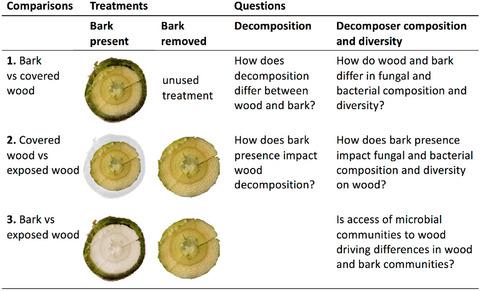当前位置:
X-MOL 学术
›
Funct. Ecol.
›
论文详情
Our official English website, www.x-mol.net, welcomes your
feedback! (Note: you will need to create a separate account there.)
Habitat‐specific effects of bark on wood decomposition: Influences of fragmentation, nitrogen concentration and microbial community composition
Functional Ecology ( IF 4.6 ) Pub Date : 2020-03-03 , DOI: 10.1111/1365-2435.13547 Jennifer M. Jones 1 , Katy D. Heath 2 , Astrid Ferrer 2 , James W. Dalling 2, 3
中文翻译:

树皮对木材分解的栖息地特定影响:破碎,氮浓度和微生物群落组成的影响
更新日期:2020-03-03
Functional Ecology ( IF 4.6 ) Pub Date : 2020-03-03 , DOI: 10.1111/1365-2435.13547 Jennifer M. Jones 1 , Katy D. Heath 2 , Astrid Ferrer 2 , James W. Dalling 2, 3
Affiliation

|
- Identifying the drivers of decomposition is critical for understanding carbon cycling dynamics in forest ecosystems. Woody biomass is an important pool of carbon, composed of bark and underlying wood which vary in structure, nutrient concentrations and exposure to the environment. We hypothesized that higher nutrient concentrations in bark would speed the decomposition of underlying wood, and that this effect would be greater in streams, where nutrients are less available to decomposers than on land.
- Replicate branches of three tree species, with and without bark, were placed in streams and on land in a lowland tropical forest in Panama. After 3 and 11 months of decomposition, we measured mass loss and nitrogen (N) concentrations and sequenced the fungal and bacterial communities of both wood and bark tissues.
- While bark decomposed faster than the underlying wood and had higher N concentrations, bark presence slowed wood mass loss. Nitrogen concentration could account for interspecific variation in wood mass loss, but not bark mass loss. In contrast, bark mass loss, but not wood mass loss, was faster in streams than on land, suggesting fragmentation is more important for bark mass loss in streams. Differences in fungal and bacterial community composition between bark and wood substrates were significant but small.
- Our results indicate that bark can slow wood decomposition instead of promoting it, and that at least for branch wood, the primary drivers of decomposition differ between bark and wood. Differences in the factors driving decomposition rate between bark and wood suggest that the contribution of bark to the decomposition of woody biomass may depend on habitat.
中文翻译:

树皮对木材分解的栖息地特定影响:破碎,氮浓度和微生物群落组成的影响
- 识别分解的驱动因素对于理解森林生态系统中的碳循环动力学至关重要。木质生物量是重要的碳库,由树皮和下面的木材组成,这些木材的结构,养分浓度和暴露于环境都会发生变化。我们假设树皮中较高的养分浓度会加速下层木材的分解,而在溪流中这种作用会更大,在溪流中,分解者比土地上的养分较少。
- 在巴拿马的低地热带森林中,将三种树种(带树皮和不带树皮)的复制树枝放在溪流和陆地上。分解3个月和11个月后,我们测量了质量损失和氮(N)浓度,并对木材和树皮组织的真菌和细菌群落进行了测序。
- 虽然树皮的分解速度快于下层木材并具有较高的N浓度,但树皮的存在减缓了木材的质量损失。氮浓度可解释木材质量损失的种间差异,但不能解释树皮质量损失。相比之下,溪流中的树皮质量损失而不是木材的质量损失要比陆地上的快,这表明碎裂对于溪流中的树皮质量损失更为重要。树皮和木材底物之间真菌和细菌群落组成的差异很大,但很小。
- 我们的结果表明,树皮可以减缓而不是促进木材分解,并且至少对于分支木材而言,树皮和木材的分解主要驱动因素有所不同。树皮和木材之间分解速率的驱动因素差异表明,树皮对木质生物量分解的贡献可能取决于栖息地。











































 京公网安备 11010802027423号
京公网安备 11010802027423号